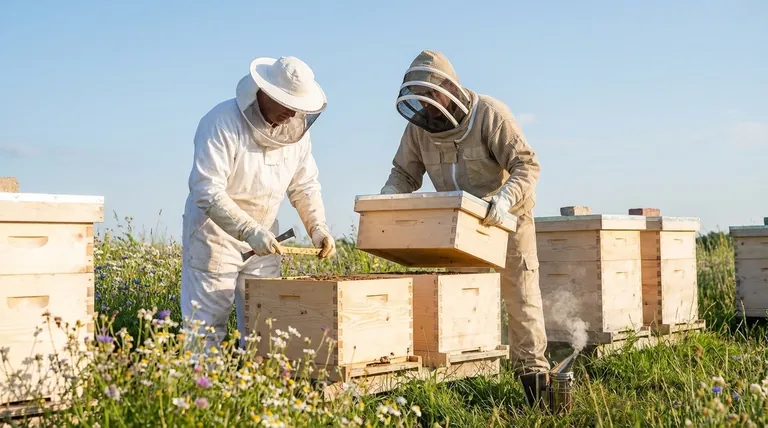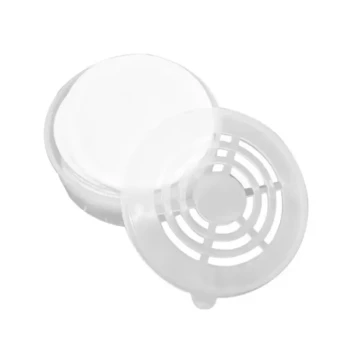When working with bees, a proper bee suit is your most critical piece of equipment. It provides essential protection from stings and prevents your regular clothing from being stained with sticky propolis. More importantly, its specific design features are engineered to keep both you and your bees calm and comfortable during hive inspections.
The purpose of a bee suit extends far beyond simple sting prevention. Its color, material, and fit are all deliberately chosen to manage bee behavior, regulate the beekeeper's temperature, and ensure a safer, more productive interaction with the colony.

The Core Functions of a Bee Suit
A well-designed bee suit serves multiple functions simultaneously. Each feature is a solution to a specific challenge beekeepers face.
Unmatched Sting Protection
The most obvious benefit is creating a physical barrier between your skin and a bee's stinger. Standard suits use thick cotton or polyester that is difficult for a stinger to penetrate.
Fully ventilated suits take this a step further. They are made of one or more layers of thick mesh, creating a space that is too deep for a stinger to reach your skin while still allowing air to circulate freely. The best ventilated suits are considered practically sting-proof.
Maintaining Calm in the Colony
Bees have evolved to perceive large, dark, moving shapes as potential predators, like a bear or badger. A white suit makes you less threatening.
By wearing white, you are less likely to trigger a defensive response from the hive. This simple color choice is a fundamental tool for managing bee temperament and reducing overall colony stress during an inspection.
Climate Control and Comfort
Beekeeping is often performed on warm, sunny days. The white color of a standard suit helps by reflecting sunlight, keeping you cooler than a darker color would.
However, in hot weather, a traditional cotton suit can still become extremely warm. Ventilated suits are the superior solution for heat, allowing constant airflow that actively cools the beekeeper. This is a significant advantage, often allowing you to work without extra layers of clothing underneath.
Preserving Your Clothing
Bees produce a resinous, sticky substance called propolis to seal gaps in the hive. It is incredibly difficult to remove from fabric. A bee suit protects your regular clothes from being permanently stained.
Understanding the Trade-offs
Choosing a bee suit involves balancing protection, comfort, and cost. There is no single "best" suit, only the best one for your specific climate and beekeeping style.
Ventilated vs. Standard Cotton Suits
A standard white suit is the industry workhorse. It is affordable, widely available, and provides good protection and a calming color for the bees. Its primary drawback is poor breathability in hot or humid weather.
A fully ventilated suit offers superior comfort and protection. The exceptional airflow makes working in the heat far more tolerable, and its multi-layer mesh is often more sting-resistant than cotton. This performance, however, comes at a significantly higher price.
The Importance of Maintenance
A bee suit is only effective if cared for properly. It must be laundered regularly to remove any lingering alarm pheromones left by bees that have attempted to sting it.
Washing also removes propolis and hive debris. A clean suit is less likely to provoke a defensive reaction from the bees on your next inspection.
Making the Right Choice for Your Goal
Your choice of suit should be guided by your climate, budget, and how frequently you plan to work your hives.
- If your primary focus is comfort in a hot climate: A fully ventilated suit is the best investment for its superior airflow and high level of protection.
- If your primary focus is reliable, cost-effective protection: A traditional white cotton suit offers an excellent balance of safety and affordability for most beekeepers.
- If your primary focus is infrequent inspections in mild weather: A simple bee jacket and veil can suffice, but a full suit always provides more comprehensive safety.
Ultimately, the right protective gear empowers you to work calmly and confidently, fostering a better experience for both you and your bees.
Summary Table:
| Benefit | Key Feature | Best For |
|---|---|---|
| Maximum Sting Protection | Thick cotton/polyester or multi-layer mesh | All beekeepers, especially in defensive colonies |
| Colony Calmness | White color to appear less threatening | Reducing defensive behavior and colony stress |
| Superior Comfort & Cooling | Ventilated mesh for airflow; white color reflects sun | Beekeeping in hot or humid climates |
| Clothing Protection | Barrier against sticky propolis and hive debris | Preserving your everyday clothing |
Ready to Work Your Hives with Confidence?
The right bee suit is an investment in your safety and productivity. HONESTBEE supplies commercial apiaries and beekeeping equipment distributors with high-performance protective gear, including durable standard suits and advanced fully-ventilated models designed for long-lasting comfort and protection.
Let us help you equip your operation for success. Contact our wholesale experts today to discuss your needs and find the perfect bee suit solution for your climate and beekeeping style.
Visual Guide

Related Products
- Wholesales Dadant Size Wooden Bee Hives for Beekeeping
- Professional Insulated Plastic Bee Hives
- Long Langstroth Style Horizontal Top Bar Hive for Wholesale
- Heavy-Duty Stainless Steel Clip-On Frame Perch
- Automatic Honey Flow Beehive 4 Frame Mini Hive for Beekeeping
People Also Ask
- What should beginners consider when purchasing beekeeping equipment? A Guide to Essential Starter Gear
- What are the essential pieces of equipment for most beekeepers? Get Started with the Right Gear
- What are the advantages of wooden bee hives? Superior Bee Health & Beekeeper Flexibility
- How often should the area under beehives be inspected and cleaned during the warm season? A Proactive Maintenance Guide
- What should you do if you find an ant nest near your beehive? Essential Strategies for Hive Protection



















